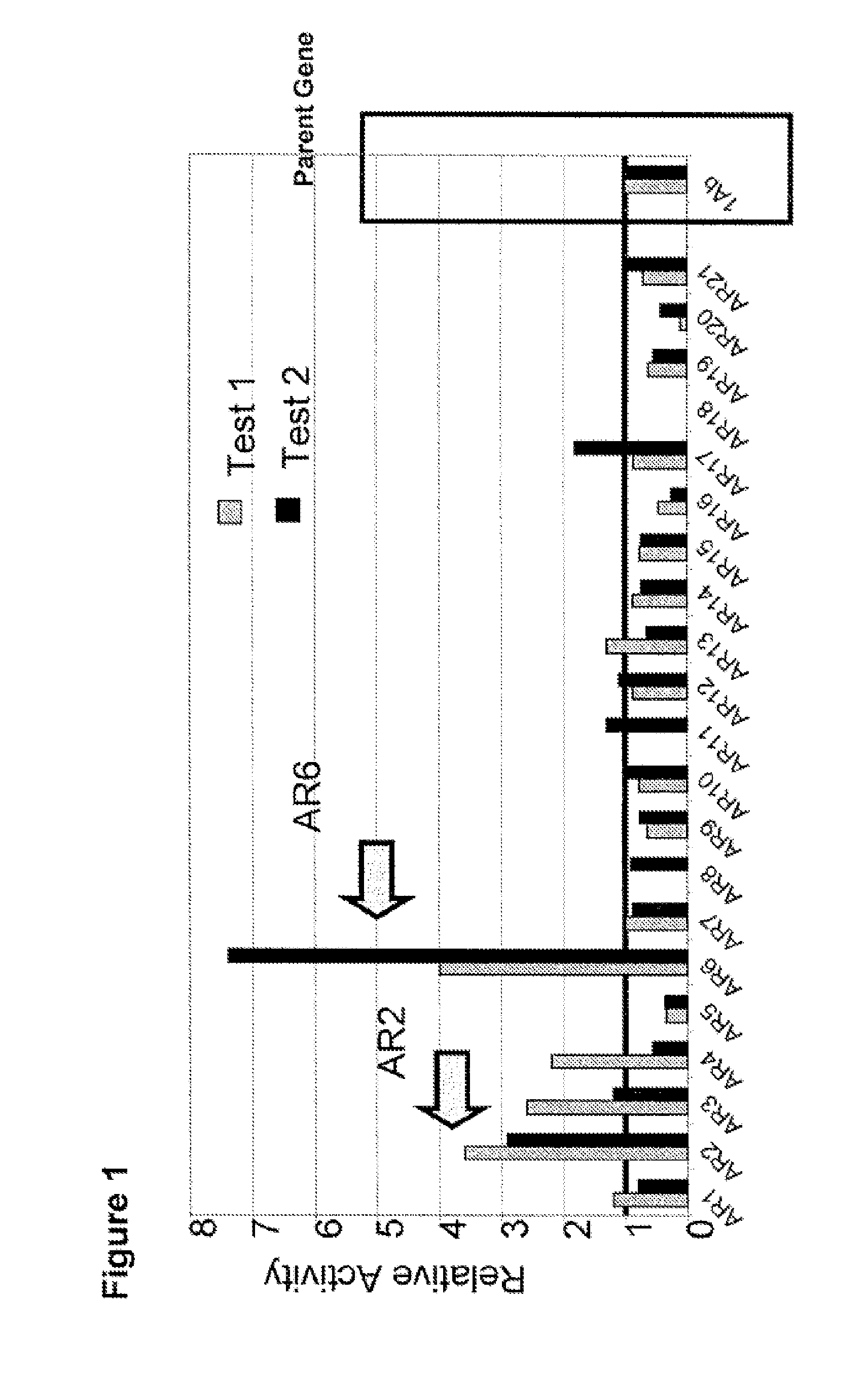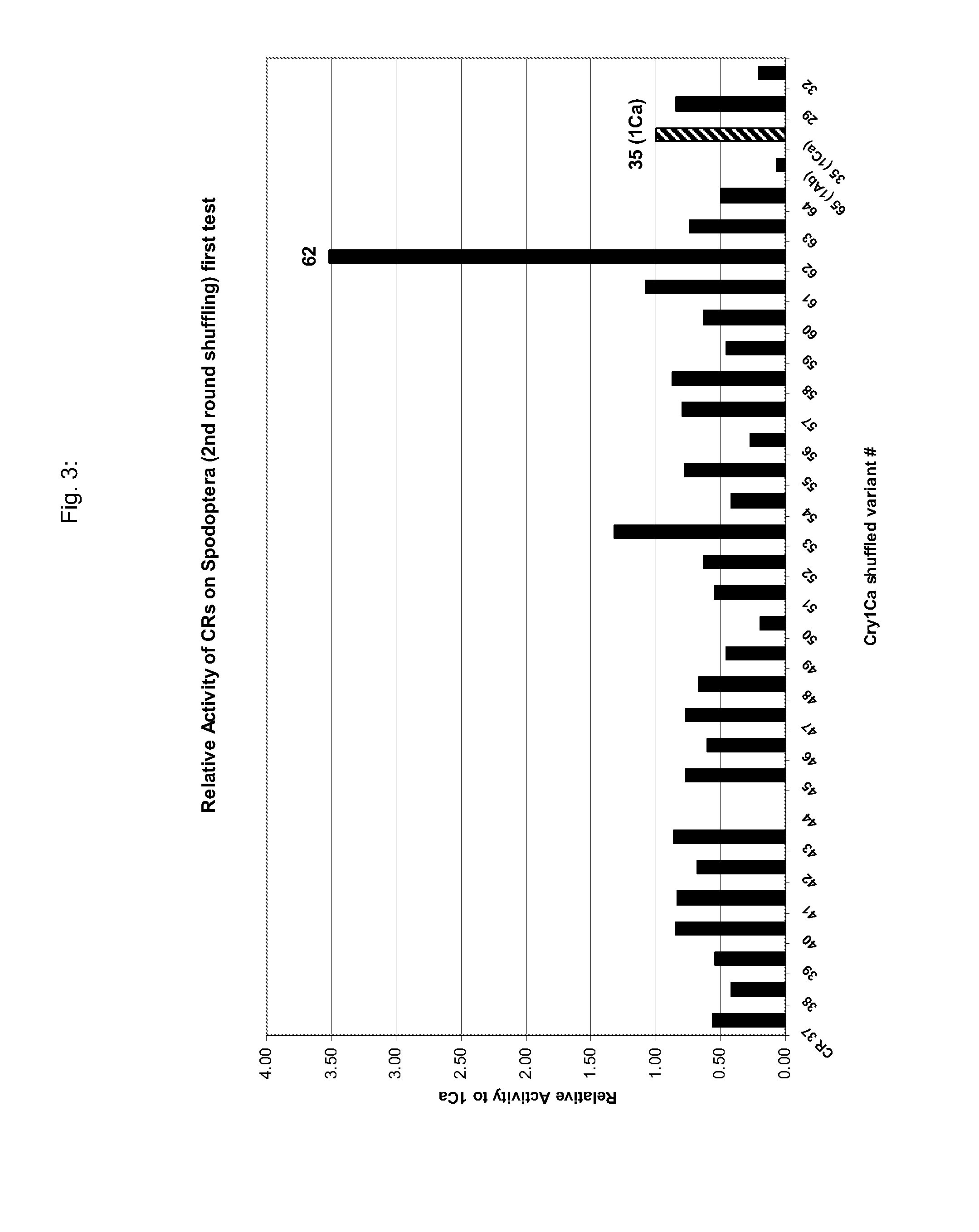Novel bacillus thuringiensis crystal polypeptides, polynucleotides, and compositions thereof
a technology of bacillus thuringiensis and crystal polypeptides, applied in the field of new bacillus thuringiensis crystal polypeptides, polynucleotides, compositions thereof, insecticidal polypeptides, can solve the problems of substantial reduction of crop yield and quality, cost and inconvenience of applying pesticides, and the inability to attack commercially valuable plants,
- Summary
- Abstract
- Description
- Claims
- Application Information
AI Technical Summary
Benefits of technology
Problems solved by technology
Method used
Image
Examples
example 1
[0111]Cry1Ac toxin is currently the most potent toxin known for control of Heliothis insects in cotton. However, Cry1Ac has very little activity on secondary pests of the Spodoptera class. Cry1Ab toxin is an excellent starting activity for cotton insect pest control since it has slightly less activity on H. zea than Cry1Ac but far superior S. exigua activity. To meet this product deficiency, a Cry1Ab-like gene was shuffled to obtain Cry1-derived polypeptides that have improved Heliothine activity while retaining essentially full Spodoptera potency. One method used to generate Cry1-derived polypeptides was ‘single gene shuffling’ (mutagenesis combined with shuffling), Shuffling of Cry1Ab was done as follows. Two overlapping fragments of a 5′ portion of the Cry1Ab gene from the translation start to the kpnI site were amplified by two separate PCR reactions from a Bt kurstaki strain that contains a Cry1Ab1 gene. These fragments were further fragmented by endonuclea...
example 2
Construction of Synthetic CR62 Gene
[0114]The DNA sequences of CR62 and the parental gene, Cry1Ca, were modified using random codon usage to create fully synthetic plant expressible genes (SEQ ID NO: 9 and SEQ ID NO:31, respectively. Table 4 provides a description of the encoded amino acid sequence differences between these genes. Following construction of synthetic CR62 and Cry1Ca genes, the coding regions were cloned into binary vector behind a strong constitutive plant viral promoter and the subsequent plasmids transformed into Agrobacterium tumefaciens C58. These strains were tested for efficacy in planta using an Agrobacterium leaf infiltration based transient expression system followed by leaf disk bioassays with Spodoptera exigua. Using this assay it was shown that both genes expressed insecticidal activity although the shuffled CR62 gene performed better than the non-shuffled wild type parent (data not shown).
example 3
Construction of Synthetic MR8′ and AR6 Genes
[0115]The DNA sequence of AR6 was targeted for modification to create a synthetic version of the AR6 coding region (SEQ ID NOS: 5 and 6) as described for CR62 in section 6.2. However, in this instance only the 5′ end of AR6 encoding the N-terminal protoxin and toxin domains were targeted for re-synthesis. This N-terminal encoding region was spliced to the already existing synthetic C-terminal protoxin encoding region from the synthetic CR62 gene to form a complete protoxin gene for plant expression. In the process of producing a synthetic AR6 gene a precursor gene was constructed. This gene, termed MR8′ (SEQ ID NO:11), encodes eight amino acid residue differences from that of AR6 (SEQ ID NO:6) in the toxin portion and four amino acid differences in the protoxin portion of the protein (Table 3).
PUM
| Property | Measurement | Unit |
|---|---|---|
| Tm | aaaaa | aaaaa |
| Tm | aaaaa | aaaaa |
| temperature | aaaaa | aaaaa |
Abstract
Description
Claims
Application Information
 Login to View More
Login to View More - R&D
- Intellectual Property
- Life Sciences
- Materials
- Tech Scout
- Unparalleled Data Quality
- Higher Quality Content
- 60% Fewer Hallucinations
Browse by: Latest US Patents, China's latest patents, Technical Efficacy Thesaurus, Application Domain, Technology Topic, Popular Technical Reports.
© 2025 PatSnap. All rights reserved.Legal|Privacy policy|Modern Slavery Act Transparency Statement|Sitemap|About US| Contact US: help@patsnap.com



